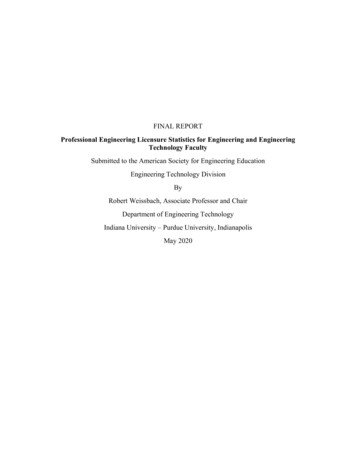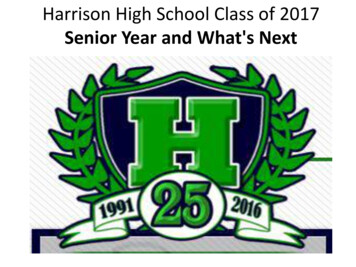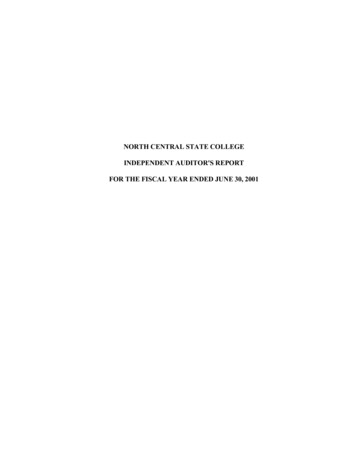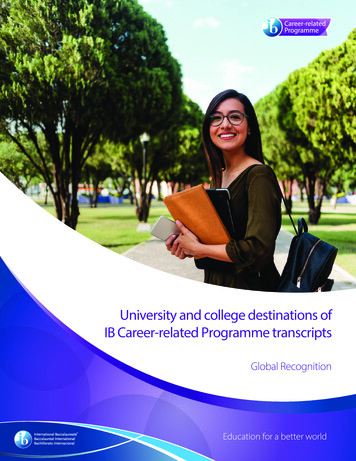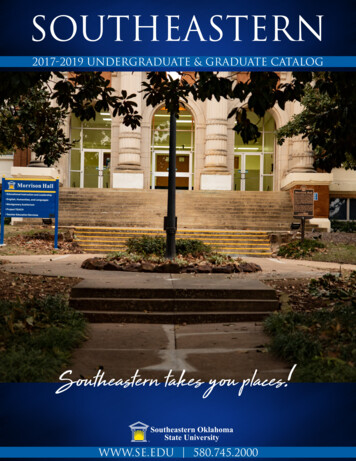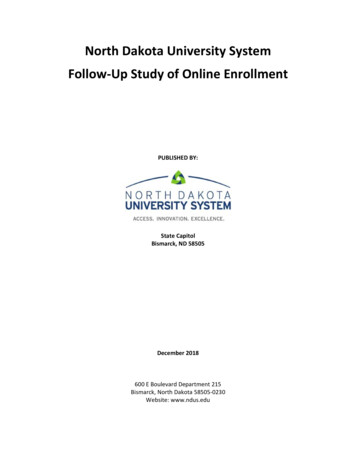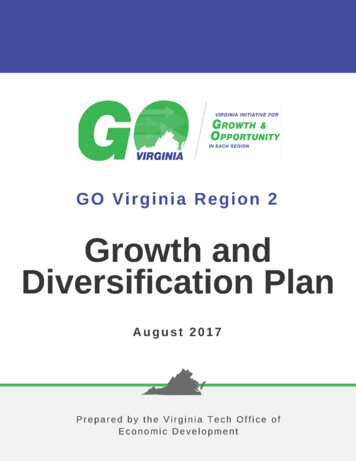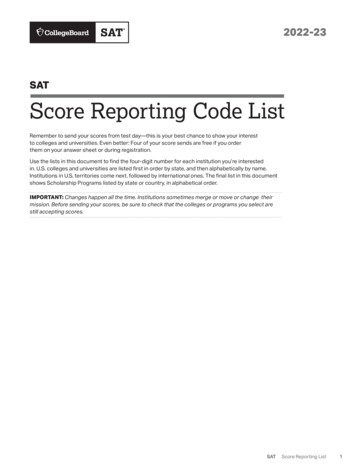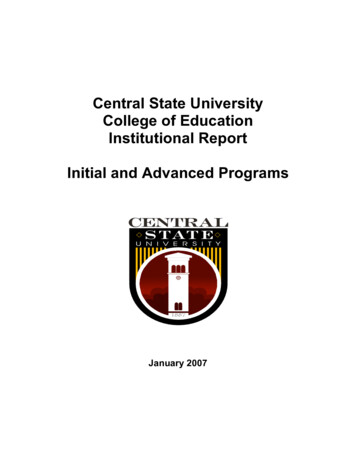
Transcription
Central State UniversityCollege of EducationInstitutional ReportInitial and Advanced ProgramsJanuary 2007
IntroductionThe InstitutionThe institutional culture of Central State University, Ohio’s only public HistoricallyBlack University, is unique in the state and contributes significantly to the trainingof minority teachers for urban and other educational settings. Central StateUniversity was established by the Ohio General Assembly in an act that createda Combined Normal and Industrial Department at Wilberforce University onMarch 19, 1887. The older institution was founded by the African MethodistEpiscopal Church in 1856 and named in honor of the great abolitionist WilliamWilberforce. The new Department was seen as a separate school, and had itsown Board of Trustees.In 1941, the General Assembly expanded the Department, which offered twoyear courses, into a College of Education and Industrial Arts, which providedfour-year college programs. In 1947, the College began operating independentlyfrom Wilberforce, continuing its programs in teacher education, industrial artsand business, and adding a four-year liberal arts program under the nameWilberforce State College. In 1951, the Ohio General Assembly changed thename to Central State College, and in November 1965, Central State wasgranted university status.Central State University is located in a rural setting. Although CSU is Ohio’s onlypredominantly African-American public institution of higher education, theenacting legislation of 1887 stipulated that the institution be “open to all personsof good moral character.” This remains true today as Central State activelypromotes ethnic diversity in its student body, faculty and staff. We believe thatthis diversity enriches the university experience, even as the institution maintainsits core historical responsibility to educate African American young people forsuccess, leadership and service in state, national and global arenas.The UnitAcademic Programs. The College of Education (COE) offers 14 academicprograms at the initial licensure level that lead to teacher licensure from the OhioDepartment of Education, and a graduate non-licensure program that is focusedupon educational leadership. Currently we have a total of 311 students enrolledin the University who have identified themselves as education majors. Becausewe have specified requirements that must be met (see Standard 2) to beadmitted officially into the College of Education, the number is more limited.There are now officially 50 Teacher candidates formally admitted to the College.Tables 1.1 and 1.2 in Standard 1 provide a breakdown on the number of precandidates and candidates in each of our licensure areas during recent terms.All of the programs (Table I.1) in teacher education, with the exception ofmultiage art and multiage music, were submitted to their respective national2
Table I.1 Program Review StatusProgramsEarly childhoodIntervention SpecialistMiddle SchoolAYA MathAYA Social StudiesAYA Language ArtsAYA Life ScienceAYA Physical SciencesHealth EducationPhysical educationArt EducationMusic EducationNo. of precandidates7325253151911552323No. ofcandidates12106155102611professional organizations on September 15, 2006. The art and music programswere submitted to the Ohio Department of Education. All programs are currentlyapproved by the Ohio Department of Education.Location of Programs: The unit consists of programs that are located in theCollege of Education and two programs that are administratively housed in theCollege of Arts and Sciences. The Advanced Program, Department ofProfessional Education and the Department of Health and Physical Educationand Recreation are located in the College of Education and are administrativelysupported by the Dean of the College of Education. The Department of Fine andPerforming Arts houses the art and music education programs and isadministratively supported by the Dean of the College of Arts and Sciences.Both Colleges are located on the main campus of Central State University.Central State University at West campus is a satellite location and does not haveits own dedicated faculty or course scheduling authority. This campus providesadditional classroom space for those candidates, primarily adults, living in theDayton area. An appointed executive director administers this campus.Distant Learning: Currently we have no formal distance learning programs, butseveral faculty blend on-line strategies with formally-scheduled classes toprovide flexibility for candidates. Our newly-opened Center for Education andNatural Sciences features a distance learning facility that affords us theopportunity to expand this dimension of our program within the next year.3
Table I.2: Program Review istAYAMathAYASocialStudiesAYALanguageArtsAYA ationAwardLevel(e.g., B SorMastersDegree)BachelorProgramLevel(Initial orAdvanced)Agency orAssociationReviewingPrograms (e.g.,State or ationalReportApproval RecognitionSubmittedStatusStatus byfor STEYESYESPendingBachelorITPNCTE, NCTM,NSTA, YESPendingN/ABachelorITP1ODE/NASMYESYESN/A4
Faculty: There are 31 faculty members serving the unit. Thirteen of these are fulltime (11 on tenure track) and 18 are serving as part-time. See Table I.3Table I.3: Academic Rank of Professional Education and Health, PhysicalEducation and Recreation Faculty for Academic Year: Fall 2006-2007Academic rsGraduateTeachingAssistantsOther (Part-time)Column Totals:# of Faculty withTenure11Non-tenured Faculty# on Tenure# Not on TenureTrackTrack001026100004071112Information about the faculty, its assignments and qualifications can be found inStandards five and six as well as in the evidence room.5
Central State UniversityCollege of Education Synopsis of Conceptual FrameworkOur WaysofKnowingOur waysofDoingCSU College of Education:A Community of LearnersCommitted to Making theWorld a Better PlaceOur WaysofBeingOur Unit vision is that we—administrators, faculty members, candidates, alumni,members of the professional community (clinical faculty, mentors, members ofour advisory panels) and community members—are working together to becomea community of learners committed to making the world a better place. Ourshared vision is one of action, collegiality, and collaboration. We strive for socialjustice and an improvement in the quality of life for those with whom we work.This vision is made real through our efforts to prepare urban educators to beoutstanding teachers for all learners. This theme is directed by core patterns andunderstandings that form the knowledge base for the conceptual framework.This conceptual framework, adopted by the Central State University educatorpreparation community, provides the foundation for preparing urban educatorswho are able to help all children become successful learners. In order toaccomplish this mission, Central State University College of Education hasadopted high expectations for candidate performance through proficiencies that6
exemplify our institutional commitments and dispositions—our ways of knowing,doing and beingCentral State University, Ohio’s only public historically black universityacademically prepares students with diverse backgrounds and educationalneeds for leadership and service in an increasingly complex and rapidlychanging world. As an open access institution, the university fosters academicexcellence through a strong liberal arts foundation and majors in selectedprofessional fields.We recognize that every year, significant numbers of urban children arrive atschool already behind, and that, instead of organizing our educational system toameliorate the problem; we organize it to exacerbate the problem. At CentralState University, we are committed to engaging in practices that focus onsuccessful learning outcomes for all students—practices that are research-basedand empirically supported.As outstanding teachers for all learners, our candidates go beyond technicalskills and engage in inquiry and reflection. They are able to work in diverseeducational environments, recognize the role of setting events, and strive toenhance the development of resilience. Finally, they themselves are resilient,communicate and work with families and community members, use technologyand aim to engage in those professional practices that are most likely to havepositive outcomes for learning.This synopsis of the Conceptual Framework is supplemented throughout theInstitutional Report with references and citations. Putting these in context isintended to make these relationships more meaningful. The completeConceptual Framework is provided on the CD that accompanies this InstitutionalReport as well as in the evidence room.7
STANDARD 1Candidate Knowledge, Skills, and DispositionsInitial and Advanced ProgramsIntroductionCandidates in the teacher education program at Central State University areprepared to meet the professional knowledge, disposition and performancerequirements of specialized professional associations (SPA), Interstate NewTeacher Assessment and Support Consortium (INTASC) standards and OhioAcademic Content Standards. The unit’s Conceptual Framework (CD andevidence room), of which these standards are a part, provides the foundationand the structure that defines the content, pedagogical and professionalknowledge, skills and dispositions necessary to help all students learn. TheConceptual Framework also supports continuous assessment of candidateperformance using multiple measures to ensure that the appropriate standardsare met. Data from these multiple measures are used by the College ofEducation (COE) for program improvement.Table 1.1 Spring 2006 Gate Distribution In the College of EducationMajorAYA ILAAYA INMAYA ISHAYA LISAYA PSIMCE LA/SSMCEMTH/SCIMUA HEEMUA MUEMUA PEDMUA VAEECEINSGEDUTotals:Gate 11931511205Gate 25141050Gate 30000001Gate 40010000Gate 010002NA4014022NA10002122NA972460587374308Tables 1.1 and 1.2 provide an overview of pre-candidate and candidateprogress, by term, through our gate structure. These numbers represent thosepre- candidates and candidates enrolled during each term at each gate. Thoseidentified at the various gates, particularly Gate 1, in Table 1.2 are notnecessarily identical to those identified in Table 1.1, as some became inactiveand others changed their majors.8
Table1.2 Fall 2007 Gate Distribution In the College of EducationMajorAYA ILAAYA INMAYA ISHAYA LISAYA PSIMCE LA/SSMCE Mth/SciMUA HEEMUA MUEMUA PEDMUA VAEECEINSUndeclaredGEDUTotals:Gate 12171243725314458016419260Gate 2301000010301830NA29Gate 311000000000830NA13Gate 401000000100220NA6Gate 1Element 1: Content Knowledge for teacher candidatesCandidates must pass the PRAXIS II Content exam before completing theprogram. A majority of candidates pass PRAXIS II on their first or secondattempt (evidence room). Those who do not experience success on their firstattempt have often benefited from a multitude of opportunities to receiveassistance, materials and other forms of support. To ensure that all candidates’learning needs are addressed, the unit offers progressive and prescriptiveinterventions, including a Proficiency Strengthening Plan (PSP), PRAXIS IISeminar course (EDU 3510), workshops, computer-based tutorials andindividualized instruction and consultations.Academic departments create assessments (frequently comprehensive exitexaminations) that undergraduate teacher candidates must pass beforegraduation. The examinations evaluate the “knowledge and skills” acquired inthe respective major courses of study. Examinations used by the variousacademic departments include multiple-choice, essay and performancedemonstrations. All teacher education programs have been submitted to therespective specialized professional associations for review on September 15,2006. We have received confirmation of their receipt by both, but as yet we haveno response/data on the quality of or national recognition for any of theseprograms.These program reports are available in the evidence room. Our Music EducationProgram has received national recognition by the National Association of9
Schools of Music, and our Art Education Program is in the process of becomingnationally recognized by the National Association of Schools of the Arts (seeevidence room). A summary of assessments used to measure content knowledge at various gates for all candidates in all programs is provided in Table 1.3.Table 1.3 Assessment of Content Knowledge at Various Gates (AllCandidates in all Programs)Gate 1: PreCandidacy2.5 GPAGate: 2Admission tothe College ofEducationMaintain 2.5 GPAGate: 3Admission toStudentTeachingMaintain 2.5GPAGate : 4StudentTeachingGate: 5 ProgramCompletionMaintain 2.5GPAPass PRAXIS IIContent Exam(after 2003)Pass PRAXISII Content(prior to 2003)EmployerEvaluation of theProgram (contentknowledge)GraduateEvaluation of theProgram (contentknowledge)The results of the Gate 1 GPA assessment/requirements by program area areprovided in Table 1.4. A minimum 2.5 GPA is required to be maintained at eachgate.Table 1.4 Gate 1 Content Knowledge Evaluation Data Summary (2.5 GPARequired)Gate 1 AssessmentsEarly Childhood EducationSpring 2006(N 73) 2.93Fall 2007(N 80) evidence roomIntervention Specialists(N 25) 2.79(N 16) evidence roomMiddle Childhood Education(N 25) 2.34(N 9) evidence roomAdult and Young Adolescent(N 39) 2.52(N 47) evidence roomMulti-Age(N 82) 2.48(N 85) evidence roomTotal Number and Mean: (N 244) 2.66(N 237) evidence roomThe failure of MCE and MUA pre-candidates to meet the GPA requirement is theresult of a single individual in each case impacting the average GPA of therespective cohorts. Additional data examined by faculty in the COE called for asignificant increase in the number and acceleration of pre-candidates admitted tothe College of Education was needed. The plan of action adopted to achieve thisgoal is provided in Standard 2, and includes the shifting of some historicalrequirements for entering Gate 2 to other areas. Some early results indicate thatthis effort is beginning to pay dividends.10
In addition to maintaining a 2.5 GPA to evidence command of content knowledgerequired to complete Gate 2 (Table 1.5), candidates must complete their readingcore courses, their methods/field courses with at least a 2.0 in each course andcomplete at least 75% of their major/concentration courses with a 2.0 or better ineach course.Table 1.5 Gate 2 Content Knowledge Evaluation Data Summary (Maintaining 2.5GPA Required)AssessmentsEarly Childhood EducationSpring 2006(N 10) 3.25Fall 2007(N 18) evidence roomIntervention Specialists(N 6) 2.86(N 3) evidence roomMiddle Childhood Education(N 5) 2.45(N 0) N/AAdult and Young Adolescent(N 11) 2.98N 4) evidence roomMulti-Age(N 5) 2.85(N 4) evidence roomTotal Number and Mean: (N 37) 2.96(N 29) evidence roomThe performance of a single individual caused the MCE cohort to fall short of the2.5 GPA. The assessment of content knowledge required in Gate 2 (Table 1.5)reflects some of the changes in the program. We have just begun to advisestudents of the importance of completing a significant portion of theirmajor/content courses prior to enrolling in methods courses thus increasing theearlier completion of these requirements. This has also increased theconfidence in our candidates taking PRAXIS II Content examinations earlier thanhas been customary.All methods courses have been redesigned to include a field component and thefour discrete courses formerly required of ECE and INS candidates and the tworequired of MCE candidates have been reconfigured into two integrated courses,combining language arts and social studies in EDU 3665 and mathematics andscience in EDU 3775. The rationale for this reconfiguration is provided in theStandards 2 and 3 reports and adds an additional dimension to our assessmentof content knowledge. Because candidates have been advised for severalmonths that they would benefit from delaying enrolling in the older versions ofthese courses, the numbers enrolled in the fall semester of 2007 are extremelylow.Table 1.6 Gate 3 Content Knowledge Evaluation Data Summary (MaintainMinimum 2.5 GPA and Pass PRAXIS II Content ExaminationAssessmentsSpring 2006Fall 2007Early Childhood Education (GPA mean)(N 0) N/A(N 8) evidence roomIntervention Specialists (GPA mean)(N 2) 3.5(N 3) evidence room11
Middle Childhood Education (GPA mean)(N 1) 3.0(N 0) N/AAdult and Young Adolescent (GPA mean)(N 0) N/A(N 2) evidence roomMulti-Age (GPA mean)(N 1) 3.0(N 0) N/ATotal Number and Mean: (N 4) 3.2Number and Percent who have passed (N 3) 75%PRAXIS II Content Examinations:(N 13) 3.3 evidence room(N 7) 53.8%The acceleration of candidates from Gate 2 to Gate 3 increased significantly fromthe spring 2006 semester to the fall 2007 semester as advising improved and thetotal redesign of the College of Education began to have an impact on candidatesuccess. Preliminary registration data indicate that this increase will be evengreater in the spring 2007 term (evidence room). All of the candidates in Gate 3and 4 for both semesters (Tables 1.6 and 1.7) entered Central State Universityprior to the 2002-2003 academic year and are not required to pass the PRAXIS IIexaminations prior to student teaching. The data, therefore, should not beunderstood to represent our final PRAXIS II pass rates which are provided in theevidence room by program.Table 1.7 Gate 4 Content Knowledge Evaluation Data Summary (MaintainMinimum 2.5 GPA and Pass PRAXIS II Content ExaminationAssessmentsSpring 2006Fall 2007Early Childhood Education (GPA mean)(N 2) 3.75(N 2) evidence roomIntervention Specialists (GPA mean)(N 2) 3.50(N 2) evidence roomMiddle Childhood Education (GPA mean)(N 0) N/A(N 0) N/AAdult and Young Adolescent (GPA mean)(N 1) 3.50(N 1) evidence roomMulti-Age (GPA mean)(N 5) 3.35(N 1) evidence roomTotal Number and Mean: (N 10) 3.5(N 6) evidence roomNumber and Percent who have passed (N 3) 30%PRAXIS II Content:(N 1) 16.6%Between the fall and spring semesters of the 2005-2006 academic year, the firstafter the transition from quarters to semesters, six of our 10 candidates who werestudent teaching decided for themselves or were advised to change their majorsas it was very evident that they would not become successful teachers. The onecandidate who discontinued student teaching during the fall 2007 semester didso for financial reasons and expects to re-enroll during the spring 2007 semester.Table 1.8 Gate 5 Content Knowledge Evaluation Data SummaryAssessmentCompleted PRAXIS IIContent Examination2004-2005(N 4) 100%2005-2006(N 9 ) 100%2006-2007N/A12
Completed State Entry YearRequirement (PRAXIS III)Graduate Evaluation ofContent Knowledge (Numberand Mean)Employer Evaluation ofContent Knowledge (Numberand Mean)N/A(PerformanceRange 3-5)N 4/Mean 3.75(PerformanceRange 3-5)N 3/Mean 4(N 16) 93.8%Pass rate(PerformanceRange 3-5)N 14/ Mean 4.13(PerformanceRange 2-5)N 7/Mean 3.74N/A(PerformanceRange)evidence room(PerformanceRange)evidence roomIn spite of the low numbers of completers in the last two years, (Table 1.8) thesedata represent an increase over previous years. Conditions in the College ofEducation were such that many pre-candidates and candidates were enrolled inthe program for more than five years. Many of these never formally soughtformal admission to the College of Education and were therefore, unable to enrollin junior or senior level courses. As unit and state licensure requirementschanged over time, significant numbers of them continued to complete coursesto meet earlier requirements, thus increasing the credits necessary to completetheir programs.This also resulted in some pre-candidates and candidates earning more credithours than the university required, but continued to need additional courses tocomplete their respective programs in the College of Education. Other precandidates and candidates reported that they were financially unable to continue,had changed their career plans, and/or were simply not capable of completingtheir programs successfully. A number of these individuals changed their majorsand successfully completed alternative programs offered by the university.Until this past summer (2006), the evaluation of content knowledge for AYA andMCE pre-candidates and candidates was limited to their GPA’s in the respectivecontent areas and performance evaluations by clinical faculty and universitysupervisors during field and clinical experiences.During the summer of 2006, faculty from the departments of Humanities(language arts and history) and Mathematics and Science worked with facultyfrom the College of Education to address how we might improve our assessmentof content knowledge. The assessments for AYA and MCE candidates (EnglishProficiency Exam and MTH 3000 Portfolio) are the only ones identified in Table1.9 that predate this summer collaboration effort. The assessment range on theEnglish Proficiency Exam is 0 – 6 and the necessary performance standard is 4.None of the AYA or MCE language arts candidates scored below a 4 andcollectively performed above expectations (4.9 – 5.7).13
Table 1.9 Assessment of Content Knowledge in Specific ProgramsProgramContent KnowledgeAssessmentsAYA Integrated Language Arts English Proficiency ExamAnd MCE Language Arts(Performance Range 3 – 6)AYA Integrated MathematicsAnd MCE MathematicsEarly Childhood EducationEarly Childhood EducationAssessment Data(Number and Mean or %)04-05: AYA (N 24, 4.9)05-06: AYA (N 12, 5.5)04-05 MCE (N 3, 5.7)05-06 MCE (N 8, 5.0)MTH 3000 Geometry for Teachers04-05: AYA (N 0, N/A)Portfolio Assessment05-06: AYA (N 4, 111.5.5)(Performance Range 101 - 120)04-05 MCE (N 3, 116.3)05-06 MCE (N 2, 107.0)ECE Child Study Project04-05: (N 6, 2.75)(Performance Range 0 – 4)05-06: (N 7, 2.45)ECE Literacy Investigation: (Action04-05: (N 9) US 22,3%Research Project)S 33.3%Unsatisfactory-UST 44.4%Satisfactory-S05-06: (N 7) US 0%Target-TS 0%T 100%The assessments of content knowledge for individual programs identified inTable 1.10 resulted from this collaborative effort and are being administered forthe first time during finals week of the fall 2007 semester. Summaries of the datagenerated by these assessments will be located in the evidence room as soon asthey become available.Table 1.10 First Time Assessments of Content Knowledge in SpecificProgram AreasAYA Physical ScienceChemistry 1201 Final Examination See Evidence RoomProgramAYA and MCELanguage ArtsAYA and MCE SocialStudiesIntervention SpecialistAYA and MCE LifeScienceAYA Physical ScienceContentKnowledgePHY 4431(ModernPhysics) FinalAssessmentsExaminationCanon Formation PaperCHM 4797 – UndergraduateHistory 4995 Final ExaminationResearchIEP/Transitions AssessmentHistory4371 Final ExaminationinstrumentBiology 1801 Final ExaminationAssessment of BIO 2400 LabReportsChemistry 1201 Final ExaminationAssessment Data(Number and Mean)See Evidence RoomSee Evidence RoomSee Evidence RoomSee Evidence RoomSee Evidence RoomPHY 4431 (Modern Physics) FinalExaminationCHM 4797 – UndergraduateResearch14
All of the key assessments/measures being used by the College of Educationand other academic departments to demonstrate that candidates know thesubject matter that they plan to teach are included in the College of EducationAssessment System (CD, evidence room and Standard 2). We have a system inplace to help us identify the employers of our graduates in order to solicit theirevaluation of teacher (graduates) command of content knowledge. We do thesame with graduates themselves. We have electronically prepared thesesurveys so as to increase the rates of response. See the form and the datasummary tables in the evidence room.Advanced ProgramThe advanced program is designed for teachers who already hold a teachinglicense, or who are eligible for a license. The knowledge bases are the NationalBoard of Professional Teaching Standards (NBPTS) propositions and theresearch on teacher-leaders for the overall program. The element of experienceis added to the knowledge of student development and the knowledge of contentto inform the professional teacher’s practice. The advanced program is deliveredthrough a set of core courses in addition to three cognate areas: The teacherleader cognate, the technology leader cognate, and the literacy leader cognate.The knowledge areas for the cognate areas are informed by the research onteacher-leadership, the International Standards for Technology Education (ISTE)for Technology Facilitation and the International Reading Association (IRA)Standards for Reading Professionals – Reading Specialist/Literacy CoachStandards. The knowledge base of the content areas includes factualinformation as well as central organizing concepts – and the ways in which newknowledge is created, including the forms of creative investigation thatcharacterize the work of scholars and artists.Currently, the advanced program is not a licensure program. However the goalsfor the courses offered in the cognate areas correspond to the standards of theIRA and the ISTE. Presently, there are only three courses required in each ofthe cognate areas. The program is currently under revision and we are seekinguniversity approval for adding the courses needed to meet all of the ISTEstandards for technology facilitation and the IRA Standards for the ReadingSpecialist/Literacy Coach. Table A1.1 represents current program goals andassessments. The alignment of core and cognate areas with program standards,National Board of Professional Teaching Standards (NBPTS), some of theInternational Reading Association (IRA) Standards and some of the InternationalSociety for Technology Education (ISTE, TF) Standards is available in theevidence room.Table A1.1 Advanced Program Goals and AssessmentsGOALSASSESSMENTS15
1. Utilize Effective Communication2. Develop Scholarship3. Develop as a Teacher Leader4. Develop Cultural Competence5. Develop CollaborationClinical Task Group Work; WrittenPaperOral ReportGPA; Portfolio; Leadership ProjectAction Research Project; GPA;Curriculum Plan Project; Portfolio;Action Research Project; Clinical TaskGroup Project;Leadership ProjectGPA; Clinical Task Group Project;Leadership Project; Clinical TaskGroup Project; Post Assessment:Cultural Competence; PortfolioGPA; Clinical task Group Project;Tables A1.1.2 and A1.1.3 summarize the performance of candidates on the oralcommunication and written communication assignments completed in thesummer 2006 in the GEDU 6620 class. Rubrics were used to determineelements to be evaluated on each project. These rubrics may be found in theevidence room. Products are scored from 1 (unacceptable) to 4 (proficient).Candidates are expected to reach the acceptable level of proficiency (3).Table A1.1.2: GEDU 6620 Current Issues Presentation Data TableCandidateRubricElement1. SpeaksClearly2. ContentUnderstanding3. Stays 5044433.754.04.03.753.25Although the lowest mean is 3.50, which is somewhat above the “acceptablelevel, it is noted that one-half the class scored a 3 and the other half scored a 4on “Stays on the Topic” in a presentation. The difference between a 3 and a 4 isthat 3 “stays on topic 90-99% of the time; whereas, 4” stays on the topic 100% ofthe time. Good planning helps one to stay on the topic. This assignmentaddresses verbal communication, which is goal 1.S.3 in the program goals. Allstudents did well on element 1, “Speaks Clearly.” Element 2, “ContentUnderstanding” relates to the content knowledge required in Standard 1. Notethat on this element, three out of the four students received a 4 and the fourth16
student received a three rating. This element will have to be followed over timeto determine if the lower score on this element becomes a trend.Table A1.1.3: GEDU 6620 Paper on Notable EducatorsStudentRubric ElementSupport for Topic (Content)Commitment (Voice)Word ChoiceRecognition of Reader(Voice)Focus on Topic 4.04.04.04.03.753.503.503.754.03.753.75All scores were between the acceptable and proficient range; however, since thisrubric assesses written communication – one of the major goals of the program the analysis will focus on growth or lack thereof between the first and secondassignment on the same element. The class mean decreased from 4.0 to 3.75 onthe “Commitment” (voice) element and increased at the same rate on the“Recognition of Reader” (Voice) element. Note that both of these elements relateto “Voice” – voice of the writer and how the writer anticipates the voice of thereader. This dimension of communication is important and relates to goal 1.S1;1.D1 in the program goals. Although the scores indicate candidates are doingfairly well on this element, there is room for improvement if we desire thatcandidates develop effective communication skills as they progress through theprogram.The advanced program has not had any graduates since the program revisionsbegan in spring 2006. At that time, there were six people in the program.Thirteen candidates entered the program in fall 2006. Therefore, we do not havematriculates. We will
Wilberforce State College. In 1951, the Ohio General Assembly changed the name to Central State College, and in November 1965, Central State was granted university status. Central State University is located in a rural setting. Although CSU is Ohio's only predominantly African-American public institution of higher education, the
